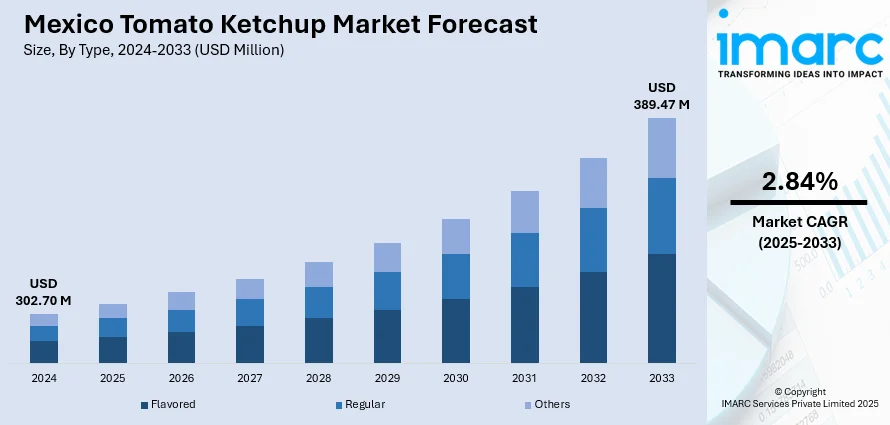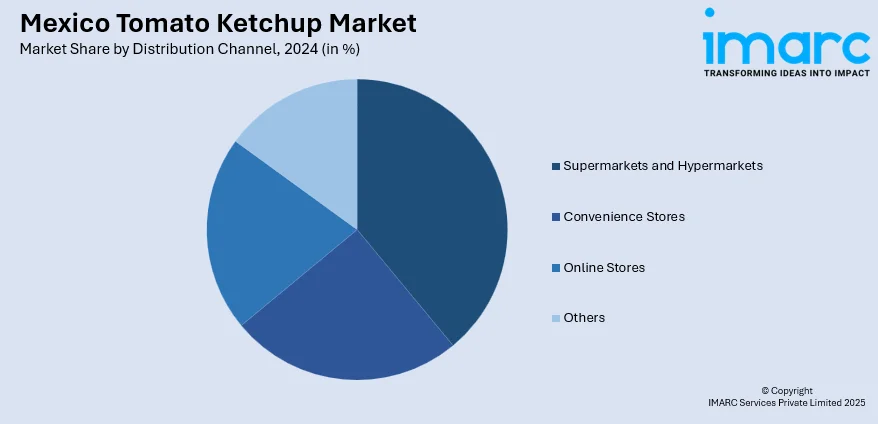
Mexico Tomato Ketchup Market Size, Share, Trends and Forecast by Type, Packaging, Distribution Channel, Application and Region, 2025-2033
Mexico Tomato Ketchup Market Overview:
The Mexico tomato ketchup market size reached USD 302.70 Million in 2024. Looking forward, IMARC Group expects the market to reach USD 389.47 Million by 2033, exhibiting a growth rate (CAGR) of 2.84% during 2025-2033. The market is growing under the influence of health-oriented consumers looking for healthy condiments, due to which, there has been an increase in demand for organic, low-sugar, and natural ingredient ketchups. Moreover, e-commerce sites are also playing a prominent role by making it easy for consumers to access a broad choice of ketchup products, improving convenience and accessibility, which is increasing the Mexico tomato ketchup market share.
|
Report Attribute
|
Key Statistics
|
|---|---|
|
Base Year
|
2024 |
|
Forecast Years
|
2025-2033
|
|
Historical Years
|
2019-2024
|
| Market Size in 2024 | USD 302.70 Million |
| Market Forecast in 2033 | USD 389.47 Million |
| Market Growth Rate 2025-2033 | 2.84% |
Mexico Tomato Ketchup Market Trends:
Health-Conscious and Clean Label Preferences
In Mexico, there is a strong shift toward health-conscious consumption that is shaping the tomato ketchup market. Consumers are increasingly looking for products that support their wellness objectives, resulting in a surge in demand for ketchups with less sugar and salt content, and those produced with organic and non-GMO ingredients. This trend is fueled by an increased understanding of the health effects of food selections and a desire to curb artificial preservatives and additives. Companies are reacting with reformulations to accommodate these tastes, highlighting clean labels and open ingredient sourcing. While this shift toward healthier alternatives is redesigning product portfolios, it is also changing marketing approaches, with companies emphasizing their dedication to quality and authenticity. Hence, the trend toward clean labelling is increasingly playing a major role in consumer buying decisions, encouraging the Mexico tomato ketchup market growth.

Fusion Flavors and Culinary Innovation
Mexican food is famous for its strong and varied flavors, and this food culture is shaping the development of tomato ketchup products in the nation. Consumers are becoming more interested in ketchups that use classic Mexican ingredients like chipotle, habanero, and tamarind to create a combination of known flavors with the traditional condiment. This is part of a wider trend for food experimentation and a need for new flavor experiences. Companies are capitalizing on this by creating specialty ketchups tailored to local tastes and mixing up conventional flavors with convenience. While such novel products appeal to risk-taking consumers, they also please consumers who want to spice up their meals with authentic Mexican flavors. Hence, the inclusion of local ingredients in ketchup recipes is enhancing consumers' relationships with their national food heritage and building a more intimate relationship with food, while broadening the role of the condiment within the Mexican gastronomic culture.
Sustainability and Local Sourcing Initiatives
Sustainability is increasingly becoming a critical driver of the Mexico tomato ketchup market growth, which largely affects production and consumer behavior. There is an increased focus on the use of locally grown, organic tomatoes to cut carbon footprints and promote local farming. Consumers are demanding brands that showcase environmental stewardship, choosing products with environmentally friendly packaging and environmentally friendly production. This trend is further encouraging manufacturers to invest in sustainability, by using recyclable material and minimizing energy usage during manufacturing. Moreover, transparency in production and sourcing practices is becoming an important marker of consumer trust and loyalty. Brands that share these values are complying with regulations while also connecting with a consumer base that is concerned with environmental and social responsibility practices, in the products they buy.
Mexico Tomato Ketchup Market Segmentation:
IMARC Group provides an analysis of the key trends in each segment of the market, along with forecasts at the country and regional levels for 2025-2033. Our report has categorized the market based on type, packaging, distribution channel, and application.
Type Insights:
- Flavored
- Regular
- Others
The report has provided a detailed breakup and analysis of the market based on the type. This includes flavored, regular, and others.
Packaging Insights:
- Pouch
- Bottle
- Others
A detailed breakup and analysis of the market based on the packaging has also been provided in the report. This includes pouch, bottle, and others.
Distribution Channel Insights:

- Supermarkets and Hypermarkets
- Convenience Stores
- Online Stores
- Others
The report has provided a detailed breakup and analysis of the market based on the distribution channel. This includes supermarkets and hypermarkets, convenience stores, online stores, and others.
Application Insights:
- Household
- Commercial
- Others
A detailed breakup and analysis of the market based on the application has also been provided in the report. This includes household, commercial, and others.
Regional Insights:
- Northern Mexico
- Central Mexico
- Southern Mexico
- Others
The report has also provided a comprehensive analysis of all the major regional markets, which include Northern Mexico, Central Mexico, Southern Mexico and others.
Competitive Landscape:
The market research report has also provided a comprehensive analysis of the competitive landscape. Competitive analysis such as market structure, key player positioning, top winning strategies, competitive dashboard, and company evaluation quadrant has been covered in the report. Also, detailed profiles of all major companies have been provided.
Mexico Tomato Ketchup Market Report Coverage:
| Report Features | Details |
|---|---|
| Base Year of the Analysis | 2024 |
| Historical Period | 2019-2024 |
| Forecast Period | 2025-2033 |
| Units | Million USD |
| Scope of the Report |
Exploration of Historical Trends and Market Outlook, Industry Catalysts and Challenges, Segment-Wise Historical and Future Market Assessment:
|
| Types Covered | Flavored, Regular, Others |
| Packagings Covered | Pouch, Bottle, Others |
| Distribution Channels Covered | Supermarkets and Hypermarkets, Convenience Stores, Online Stores, Others |
| Applications Covered | Household, Commercial, Others |
| Regions Covered | Northern Mexico, Central Mexico, Southern Mexico, Others |
| Customization Scope | 10% Free Customization |
| Post-Sale Analyst Support | 10-12 Weeks |
| Delivery Format | PDF and Excel through Email (We can also provide the editable version of the report in PPT/Word format on special request) |
Key Questions Answered in This Report:
- How has the Mexico tomato ketchup market performed so far and how will it perform in the coming years?
- What is the breakup of the Mexico tomato ketchup market on the basis of type?
- What is the breakup of the Mexico tomato ketchup market on the basis of packaging?
- What is the breakup of the Mexico tomato ketchup market on the basis of distribution channel?
- What is the breakup of the Mexico tomato ketchup market on the basis of application?
- What is the breakup of the Mexico tomato ketchup market on the basis of region?
- What are the various stages in the value chain of the Mexico tomato ketchup market?
- What are the key driving factors and challenges in the Mexico tomato ketchup market?
- What is the structure of the Mexico tomato ketchup market and who are the key players?
- What is the degree of competition in the Mexico tomato ketchup market?
Key Benefits for Stakeholders:
- IMARC’s industry report offers a comprehensive quantitative analysis of various market segments, historical and current market trends, market forecasts, and dynamics of the Mexico tomato ketchup market from 2019-2033.
- The research report provides the latest information on the market drivers, challenges, and opportunities in the Mexico tomato ketchup market.
- Porter's five forces analysis assist stakeholders in assessing the impact of new entrants, competitive rivalry, supplier power, buyer power, and the threat of substitution. It helps stakeholders to analyze the level of competition within the Mexico tomato ketchup industry and its attractiveness.
- Competitive landscape allows stakeholders to understand their competitive environment and provides an insight into the current positions of key players in the market.
Need more help?
- Speak to our experienced analysts for insights on the current market scenarios.
- Include additional segments and countries to customize the report as per your requirement.
- Gain an unparalleled competitive advantage in your domain by understanding how to utilize the report and positively impacting your operations and revenue.
- For further assistance, please connect with our analysts.
 Request Customization
Request Customization
 Speak to an Analyst
Speak to an Analyst
 Request Brochure
Request Brochure
 Inquire Before Buying
Inquire Before Buying




.webp)




.webp)












